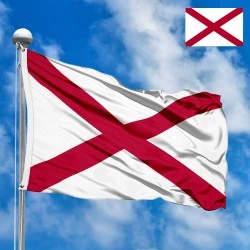Flag of China
- Flag Type: State
- Proportions (official): 2:3
- Official name: People's Republic of China
- Local name: 中华人民共和国
- Sovereignty (year): YES (1949)
- Member of Organizations: UN
- Country code, territory: CN, CHN, 156
- Capital: Beijing
- Large cities: Shanghai, Chongqing, Tianjin, Guangzhou
- Population: ~1,425,000,000 (2024, NBS)
- Religions: Folk religions ~21.9%, Buddhism ~18.2%
- Area (km²): 9 596 961
- Highest point: Mount Everest (8,848 m)
- Lowest point: Ayding Lake (-154 m)
- Currency: Chinese yuan (CNY, ¥)
- Languages: Mandarin Chinese
- Dialing code: +86
- National domain: .cn
Flag Information
General information
Demography and Culture
Economy and communications
- All Flags
- Flags of Countries by Continent
-
Flags of Organizations
- Flags of UN countries
- Flags of the European Union countries
- Flags of NATO countries
- Flags of the countries of the Organization of Islamic Cooperation
- Flags of the countries of the Organization of American States
- Flags of the Arab League countries
- Flags of the African Union countries
- Flags of the countries of the Union of South American Nations
- Flags of the Commonwealth of Nations
- Flags of the countries of the Secretariat of the Pacific Community
- Flags of the Nordic Council countries
- Flags of the Caribbean Community
- Flags of the countries of the Association of Southeast Asian Nations
- Flags of the East African Community
- Flags of the countries of the Organization of Turkic States
- LGBT Community Flags
- Historical Flags
- Ethnic Flags
- Flags of the USA (states)
Description
The national flag of the People's Republic of China (PRC) is a potent emblem, deeply imbued with the political ideology and revolutionary history that shaped modern China. Known as the "Five-star Red Flag" (WuxingHongqi in Mandarin), it stands as a testament to the nation's journey from turmoil to its current global prominence. More than just a national symbol, it embodies the unity of its diverse population under the leadership of the Communist Party of China (CPC) and signifies the aspirations for socialism with Chinese characteristics, reflecting a unique path to national development.
Design and Dimensions
The flag of the People's Republic of China features a dominant red field with five yellow stars in the upper-left canton. A large single star is positioned in the upper-left corner, and four smaller stars are arranged in a semicircle to its right, with one point of each smaller star pointing towards the center of the large star. The official proportions of the Chinese flag are typically 2:3 (height to width), giving it a balanced and stately appearance. This specific arrangement and color scheme are carefully chosen, each element holding profound symbolic significance for the Chinese nation.
Symbolism of the Colors and Elements
Every color and the arrangement of stars on the Chinese flag carry significant ideological and nationalistic meanings, meticulously crafted to represent the core tenets of the People's Republic of China:
-
Red Field: The overwhelming red field symbolizes the Chinese Communist Revolution. It represents the blood of the revolutionaries who fought and sacrificed for the establishment of the People's Republic of China. Red is also a traditional color associated with the Chinese people and culture, often signifying happiness, prosperity, and good fortune. In a political context, it explicitly links the flag to communism and the socialist system, embodying the revolutionary spirit and the path taken by the CPC.
-
Large Yellow Star: The prominent large yellow star in the upper-left canton represents the Communist Party of China (CPC). It signifies the leading role and guiding light of the Party in the nation's governance and development. Its golden color reflects the brightness and brilliance associated with a guiding force.
-
Four Smaller Yellow Stars: The four smaller yellow stars arranged in an arc to the right of the large star symbolize the four social classes of the Chinese people: the working class, the peasantry, the urban petty bourgeoisie, and the national bourgeoisie. Their arrangement, with one point of each star pointing towards the large star, signifies the unity and solidarity of these classes under the leadership of the Communist Party of China. This arrangement emphasizes the central role of the CPC in uniting all sectors of society to achieve national goals and build socialism. The yellow color of these stars is often associated with the Han Chinese people, further emphasizing national identity.
History of Creation and Adoption
The creation of the "Five-star Red Flag" was a deliberate process in the formative years of the People's Republic of China. Before 1949, various revolutionary and political flags were used by different factions during China's tumultuous 20th century, including the nationalist flag (with a white sun on a blue canton and red field) used by the Republic of China.
After the victory of the Communist Party in the Chinese Civil War and the impending establishment of the PRC, a new national flag was needed to represent the new state. In July 1949, a committee was formed to solicit flag designs from the public. Out of approximately 3,000 submissions, the design by Zeng Liansong, an economist and artist, was ultimately chosen.
Zeng Liansong's original design included a hammer and sickle within the large star, symbolizing the Communist Party's direct link to the international communist movement. However, this element was removed after discussions, primarily because it was felt that the large star already sufficiently represented the CPC, and adding the hammer and sickle might imply that China was exclusively a workers' and peasants' state, rather than representing the broader alliance of the four classes.
The "Five-star Red Flag" was officially proclaimed the national flag of the People's Republic of China on September 27, 1949, at the First Plenary Session of the Chinese People's Political Consultative Conference. It was first hoisted in Tiananmen Square on October 1, 1949, marking the formal proclamation of the People's Republic of China by Mao Zedong. This flag became a powerful emblem of the new socialist state and its revolutionary achievements.
Significance for the Inhabitants
For the people of China, the national flag is an exceptionally significant and highly revered symbol. It represents the founding of modern China and its transformation into a unified, independent, and strong nation under the leadership of the Communist Party. The flag embodies the collective memory of the struggles and sacrifices made to achieve national liberation and the ongoing efforts to build a prosperous and harmonious socialist society.
It instills a profound sense of national pride, patriotism, and unity among its vast and diverse population. Displayed prominently in public spaces, government buildings, schools, and during national holidays and major events (such as the National Day on October 1st and the Chinese New Year), the flag serves as a constant visual reminder of the nation's identity, its socialist values, and its aspirations for continued growth and international standing. It symbolizes the resilience of the Chinese people and their collective journey towards national rejuvenation.
Interesting Facts
-
Designer's Background: Zeng Liansong, the designer, was an economist, not a professional vexillologist, highlighting the grassroots appeal of the design competition.
-
No Hammer and Sickle: The removal of the hammer and sickle from the large star in the final design distinguishes the Chinese flag from many other communist state flags, emphasizing a broader national unity under the CPC rather than a narrow class-based representation.
-
"Golden Ratio" Proportions: While officially 2:3, the flag's dimensions and the placement of the stars are often meticulously specified in official guidelines, sometimes approaching proportions reminiscent of the golden ratio, though this is debated.
-
Tiananmen Square Symbolism: The flag's first hoisting in Tiananmen Square is a deeply symbolic moment in Chinese history, directly linking the flag to the birth of the PRC.
-
Contrasting with Taiwan: The distinct design of the PRC flag directly contrasts with the flag of the Republic of China (Taiwan), underscoring the political division and competing claims of legitimacy.
-
Global Recognition: The "Five-star Red Flag" is one of the most recognizable national flags globally, representing China's significant economic and political influence on the world stage.
-
Protective Measures: In China, there are strict laws regarding the display and treatment of the national flag, reflecting its profound national importance and the reverence it commands. Misuse or disrespect of the flag can lead to severe penalties.
In the demonstration images, full-size flags are shown with proportions of 2:3, and hand-held flags with proportions of 1:2.
Donation
Download
Completely free for commercial and non-commercial use (public domain).
You can freely use them in your news magazines, websites, software, mobile applications.
We appreciate a backlink to https://flagssite.com
Raster files - Flag of China (PNG, JPG)
 Waving flag
Waving flag
- PNG format (transparent background), 72dpi, dimensions in Pixels (px), aspect ratio 3:4.
- 15х20 px
- 30х40 px
- 60х80 px
- 120x160 px
- 240x320 px
 Sizes:
Sizes:
"v15" - image size (by height); if necessary, replace with available: v15, v30, v60, v120, v240.
!!! For resizing, use the Latin (eng) keyboard layout.
<img src="https://flagssite.com/flags/v15/20324.png" alt="Flag of China">
 Round flag
Round flag
- PNG format (transparent background), 72dpi, dimensions in Pixels (px), aspect ratio 1:1.
"d15" - image size (diameter); if necessary, replace with available: d15, d30, d60, d120, d240.
!!! For resizing, use the Latin (eng) keyboard layout.
<img src="https://flagssite.com/flags/d15/20324.png" alt="Flag of China">
 Rectangular flag 2:3
Rectangular flag 2:3
- JPG format, 72dpi, dimensions in Pixels (px), aspect ratio 2:3.
"h30" - image size (by height); if necessary, replace with available: h15, h30, h60, h120, h240, h360, h480.
!!! For resizing, use the Latin (eng) keyboard layout.
<img src="https://flagssite.com/flags/h30/20324.jpg" alt="Flag of China">








 Sizes:
Sizes:
 Sizes:
Sizes:

























